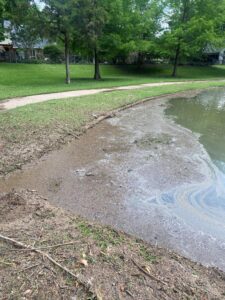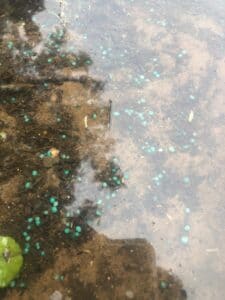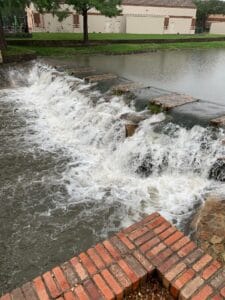Rainfall is often feast or famine here in north Texas. In recent years, we have had several spring seasons with above average rainfall. The effect of rain and resulting runoff affects both the chemistry and physical condition of ponds and lakes. Urban storm-water ponds are most likely to experience the negative impacts caused by heavy rainfall.
By design, storm-water ponds are created to capture excessive runoff from streets, rooftops, and other impermeable surfaces. Overland flow across lawns and other heavily landscaped areas also occurs. In addition to capturing excess storm-water, these ponds are intended to trap sediment and filter trash, pollutants, nutrients, and other foreign substances. This process helps cleanse our municipal water supplies. However, flood conditions can temporarily impair the appearance and water quality of retention ponds.

Organic Flood Debris
One of the most noticeable effects is the large amount of man-made trash and/or organic flood debris that is carried into the pond. Trash is unsightly and can lead to fountain clogs and obstructed overflow drains. Organic debris appears as a brown layer on the pond surface and is made up of natural components such as wood, grass clippings, and other organic detritus. Fortunately, this debris typically dissipates naturally within a week or so after the rains cease. Other things you may notice are oily sheens caused by petroleum based street runoff and foamy, white conditions caused by biofilms.
Muddy or “turbid” water usually occurs after a rain. But the biggest problem is often unseen.
Runoff across un-vegetated land gathers loose soil and deposits it in the nearest body of water. Silt fences and other control measures are put into place to minimize this effect. However, fine sediments often pass through or around these materials. In most cases, muddy water will naturally settle a few weeks after rains cease. In severe cases, products such as alum or gypsum can be applied to chemically settle the suspended sediment. These products should only be used once the threat of rain has ended and the source of the sediment has been addressed.
The biggest problem caused by heavy runoff initially goes unnoticed to the human eye. Storm-water surges carry high levels of phosphorus and nitrogen. These nutrients are fuel for the out of control growth of noxious algae and pesky aquatic weeds. Due to ongoing development and the heavy use of lawn fertilizer, this is something that is not going away any time soon. As a general rule, you should expect rapidly growing algae blooms shortly after the rains have ceased and sunlight returns. It is universally recommended in the aquatics industry to limit the use of landscape fertilizer around ponds. At a minimum, fertilizer should not be applied on the slopes that drain to the pond. On flat areas, a 20 foot buffer zone should be put into place between the pond’s edge and any fertilizer applications.
Don’t apply pond products during periods of rainfall.
It should be noted, that rainy conditions are not conducive to effective treatment with algaecides and herbicides. These products need several hours of direct sunlight to be effective. Furthermore, applying these products to overflowing ponds is a violation of both federal and state environmental laws. As a result, pond owners may have to temporarily tolerate some degree of aquatic growth until conditions allow proper treatment.

Lawn Fertilizer In Pond
Nutrients are not the only pollutant present in storm-water flows.
Other examples can include, but are not limited to: hazardous household products, non-aquatic registered herbicides, insecticides, rodenticides, chlorine, and sewage. These substances have both direct and indirect negative effects on fish and wildlife. In fact, it is common to see a few dead fish, turtles, or amphibians after a severe flood. Proper usage and disposal of these materials is the best defense against their toxic effects to the environment.
Heavy storm-water flows can result in complete displacement of the water in urban ponds. This drastically transforms the aquatic ecosystem. This can happen so rapidly that fish may not be able to adjust to these changes. As a result, regular metabolic conditions are disrupted and can lead to potential fish kills. Pond turnovers can also be caused by heavy rain events. A turnover occurs when cool rainwater sinks to the bottom of the pond. This causes dilution of the available dissolved oxygen and can lead to a massive fish kill. The likelihood of a rain induced turnover is highest during the heat of the summer. Bottom diffused aeration systems offer insurance against devastating pond turnovers.
Don’t worry (too much) about losing fish through overflows in heavy rain conditions. Instead, watch for new arrivals.
Pond owners are often concerned about losing their fish down drain structures and over spillways under flood conditions. Though this is a legitimate concern, most native gamefish and forage species are well adapted to swim against current and do not actively seek to go downstream. However, in extreme floods, it is quite common to see small sunfish or other forage species below the pond outflow or stranded up on the shoreline once water levels recede. You may also notice larger fish trapped in overflow grates. The good news is that the natural reproductive capacity of the remaining fish will quickly offset any loss due to flooding.

Flooding Spillway
Just as you may lose some fish, you may also gain some fish. In fact, this is a greater concern. Ponds in the vicinity of creeks, streams, or other public water bodies are prone to getting infested with undesirable and/or invasive fish species. These can include carp, buffalo, gar, green sunfish, and bullhead catfish. Carp species in particular are one of the few fish that actively seek to move downstream. Once carp become established in a pond, they can lead to poor water quality and muddy conditions. Unfortunately, there is little that can be done to stop undesirable species migration under flood conditions.
